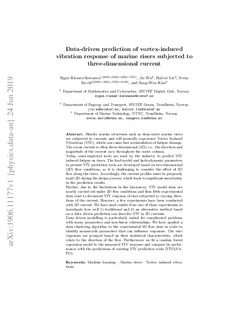| dc.contributor.author | Riemer-Sørensen, Signe | |
| dc.contributor.author | Wu, Jie | |
| dc.contributor.author | Lie, Halvor | |
| dc.contributor.author | Sævik, Svein | |
| dc.contributor.author | Kim, Sangwoo | |
| dc.date.accessioned | 2020-02-03T14:14:59Z | |
| dc.date.available | 2020-02-03T14:14:59Z | |
| dc.date.created | 2020-01-17T09:33:43Z | |
| dc.date.issued | 2019 | |
| dc.identifier.isbn | 978-3-030-35664-4 | |
| dc.identifier.uri | http://hdl.handle.net/11250/2639367 | |
| dc.description.abstract | Slender marine structures such as deep-water marine risers are subjected to currents and will normally experience Vortex Induced Vibrations (VIV), which can cause fast accumulation of fatigue damage. The ocean current is often three-dimensional (3D), i.e., the direction and magnitude of the current vary throughout the water column. Today, semi-empirical tools are used by the industry to predict VIV induced fatigue on risers. The load model and hydrodynamic parameters in present VIV prediction tools are developed based on two-dimensional (2D) flow conditions, as it is challenging to consider the effect of 3D flow along the risers. Accordingly, the current profiles must be purposely made 2D during the design process, which leads to significant uncertainty in the prediction results. Further, due to the limitations in the laboratory, VIV model tests are mostly carried out under 2D flow conditions and thus little experimental data exist to document VIV response of riser subjected to varying directions of the current. However, a few experiments have been conducted with 3D current. We have used results from one of these experiments to investigate how well 1) traditional and 2) an alternative method based on a data driven prediction can describe VIV in 3D currents. Data driven modelling is particularly suited for complicated problems with many parameters and non-linear relationships. We have applied a data clustering algorithm to the experimental 3D flow data in order to identify measurable parameters that can influence responses. The riser responses are grouped based on their statistical characteristics, which relate to the direction of the flow. Furthermore we fit a random forest regression model to the measured VIV response and compare its performance with the predictions of existing VIV prediction tools (VIVANA-FD). | nb_NO |
| dc.language.iso | eng | nb_NO |
| dc.publisher | Springer Verlag | nb_NO |
| dc.relation.ispartof | Nordic Artificial Intelligence Research and Development: Third Symposium of the Norwegian AI Society, NAIS 2019 | |
| dc.title | Data-Driven Prediction of Vortex-Induced Vibration Response of Marine Risers Subjected to Three-Dimensional Current | nb_NO |
| dc.type | Chapter | nb_NO |
| dc.description.version | acceptedVersion | nb_NO |
| dc.source.pagenumber | 78-89 | nb_NO |
| dc.identifier.doi | https://doi.org/10.1007/978-3-030-35664-4_8 | |
| dc.identifier.cristin | 1775430 | |
| dc.description.localcode | This is a post-peer-review, pre-copyedit version of an article. Locked until 22.11.2020 due to copyright restrictions. The final authenticated version is available online at: https://doi.org/10.1007/978-3-030-35664-4_8 | nb_NO |
| cristin.unitcode | 194,64,20,0 | |
| cristin.unitname | Institutt for marin teknikk | |
| cristin.ispublished | true | |
| cristin.fulltext | original | |
| cristin.qualitycode | 1 | |
